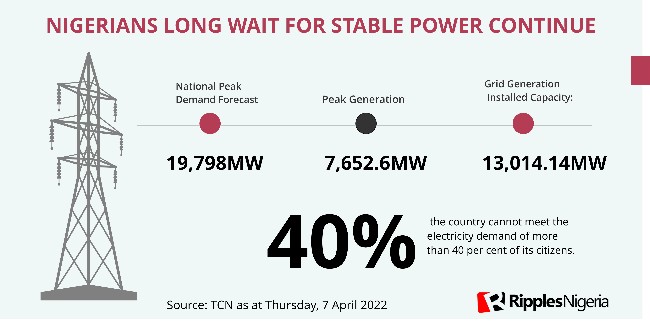Ripples Metrics
RipplesMetrics: Despite promises, Nigeria in darkness, as govt pumps billions to power sector

One of the promises of the administration of President Muhammadu Buhari at the time it came to power was to fix Nigeria’s electricity problem.
Specifically, Nigerians were assured that in the Economic Growth and Recovery Plan at least 10,000 MW will be generated by the end of 2020.
It is 414 days before the administration comes to an end, and data show Nigeria is still struggling to go beyond 5000MW of generated power.
In its latest report, the Nigeria Electricity System Operator revealed that as at Thursday April 7, 2022, the peak generation was only 4,531MW.
It also placed the National Peak Demand Forecast at 19,798MW.
This struggle comes despite huge financial commitment to the sector.
According to budget documents seen by Ripples Nigeria, the Transmission Company of Nigeria (TCN), charged with wheeling generated electricity to Nigerian homes, has been allocated over N252,541,322,907.00 (N252.54bn) between 2015 and 2022.
Apart from the budgetary allocations, TCN also received fundings and loans for capital projects from donors and international organisations such as the World Bank.
READ ALSO: RipplesMetrics: States pile up debt as oil money dries up, investors stay away
In 2018, for instance, the International Development Association (IDA) approved a $404 million facility to strengthen Nigeria’s transmission network capacity.
Blame game
Just as over 40 percent of Nigeria’s population remains without power, agencies of government throw shades at one another.
In 2020, the Electricity distribution companies (DisCos) blamed the Transmission Company of Nigeria (TCN) for erratic power supply in Nigeria.
Also, the Nigerian Electricity Regulatory Commission (NERC) said TCN’s operating generation capacity was far below the total installed generation capacity of 12,522MW.
“The entire infrastructure is essentially radial, without redundancies thus creating inherent reliability issues,” the regulator said in a post on its official website.
But the Transmission Company of Nigeria (TCN) is also blaming the power generation companies of not providing enough power despite having a wheeling capacity of 8,000MW.
Way forward
The Federal Government has set its sight to generate 30,000MW by 2030 with 3,000MW coming from renewables and 27,000MW from its power plants to serve its over 200 million people.
For this to be realistic, huge Investments in Solar remains a viable source to add to Nigeria’s abysmal power generation.
Join the conversation
Support Ripples Nigeria, hold up solutions journalism
Balanced, fearless journalism driven by data comes at huge financial costs.
As a media platform, we hold leadership accountable and will not trade the right to press freedom and free speech for a piece of cake.
If you like what we do, and are ready to uphold solutions journalism, kindly donate to the Ripples Nigeria cause.
Your support would help to ensure that citizens and institutions continue to have free access to credible and reliable information for societal development.


























